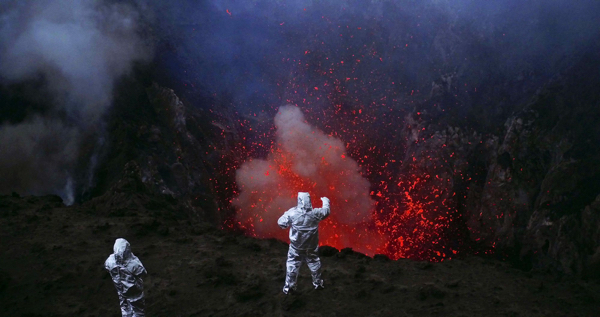Movie review by Greg Carlson
Inspired by the work of volcanologist Clive Oppenheimer and his 2011 book “Eruptions That Shook the World,” Werner Herzog dazzles and mesmerizes viewers of “Into the Inferno,” a nonfiction examination that encapsulates the essence of the legendary filmmaker’s lasting appeal. Narrated by Herzog in the familiar style poetically juxtaposing bleakly comic admonishments about collective human foolishness against sobering facts that can take one’s breath away, “Into the Inferno” balances the scientific and the magical.
Even though Herzog is the director of “Into the Inferno,” a title card shares the authorial credit by identifying “a film by Werner Herzog and Clive Oppenheimer.” Herzog’s generosity could additionally extend to longtime cinematographer Peter Zeitlinger. Zeitlinger’s gorgeous images don’t need much help to appear awe-inspiring – flowing, spouting, arcing, fuming molten rock in impossible shades of red – but his expert contributions are among the film’s chief joys.
In his review, Matt Zoller Seitz asserted that “If you go into a Herzog documentary hoping for a definitive, deep look at a certain subject, you’re bound to come away disappointed.” The comment, part of an argument that claims Herzog has regularly depended on brief episodes favoring obsessives, could apply just as easily to “Lo and Behold: Reveries of the Connected World,” the director’s other 2016 nonfiction feature (last year, the workaholic also polished off the volcanically related but less well-received fiction film “Salt and Fire).
“Into the Inferno” also partially functions – like so many of Herzog’s films – as a diary that traces the philosophical preoccupations of its famous writer over the span of a creative lifetime. The most obvious links in this regard include the acknowledgment of Herzog first crossing paths with Oppenheimer during “Encounters at the End of the World.” A second ligament is 1977’s “La Soufriere,” Herzog’s short documentary about the possibility of an eruption on the island of Guadeloupe. At this point in his storied career, Herzog is completely comfortable (and self-aware) as everyone’s favorite enunciator of doom, darkness, and death, but the way he so often banters and shares screen space with brilliant people like Oppenheimer is also a genuine draw that reveals an optimism missing from the apocalyptic pronouncements.
Herzog has always been an intrepid wanderer, and the geography traversed in “Into the Inferno” is as illuminating as the geology lessons provided by Oppenheimer. From Iceland to Ethiopia to Indonesia, no location seems out of reach to the globetrotting filmmaker. Among the many highlights is a visit to North Korea, and Herzog’s accompanying voiceover suggests incredulousness, curiosity, skepticism, and even something approaching respect at the patriotism on display. In accompanying narration, Herzog comments on the nation’s propaganda apparatus, citing the “monumental unity and fervent emotion” of the subjects.
As demonstrated by the complex North Koreans, belief, in a multiplicity of incarnations, permeates the human side of “Into the Inferno.” Manifested in the ultimate sacrifice of pioneering volcanic documenters Katia and Maurice Krafft, who were instantly incinerated in a pyroclastic flow in Japan in 1991, as well as in the Vanuatuan “cargo cultists” who await the return of the godlike American G.I. John Frum and his “copious consumer goods,” true believers are catnip to Herzog. At 74, the man shows no sign of letting up his furious pace as one of our most reliable chroniclers of humanness, and for that I am thankful.
